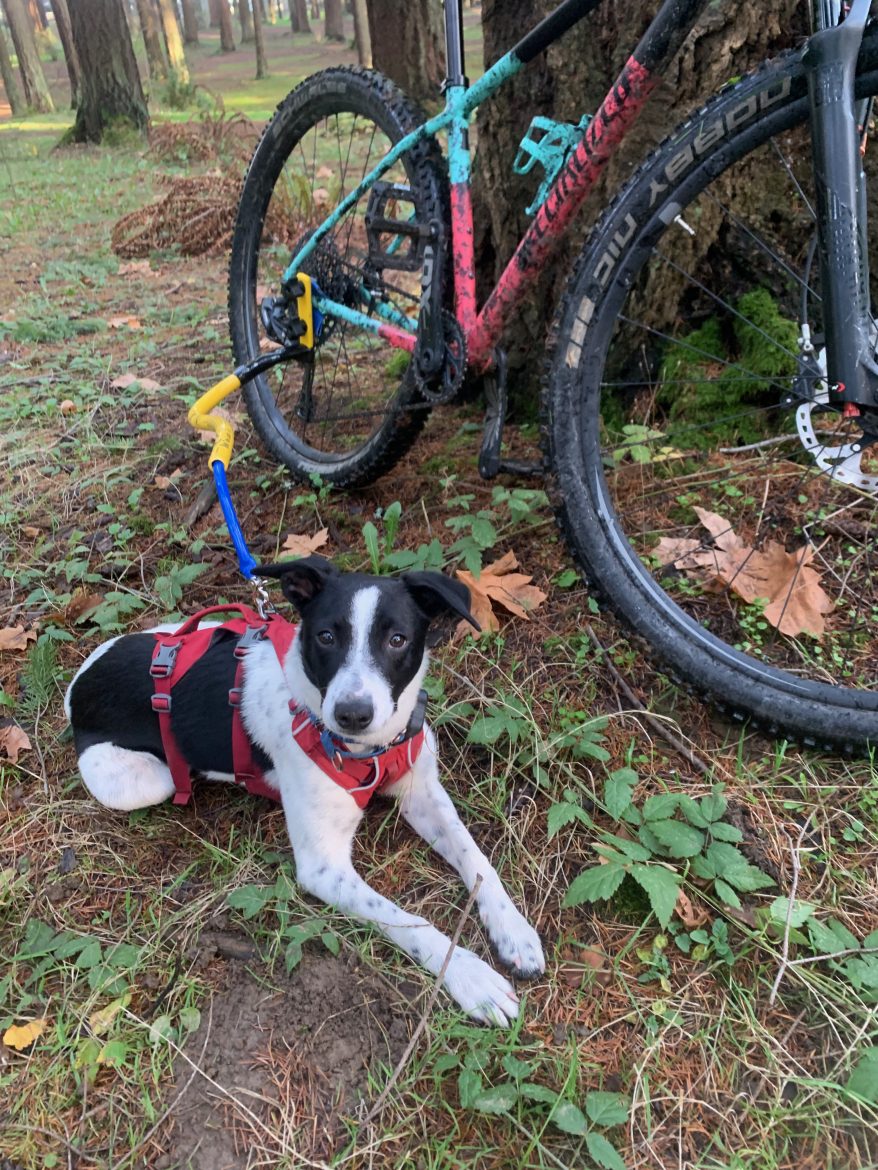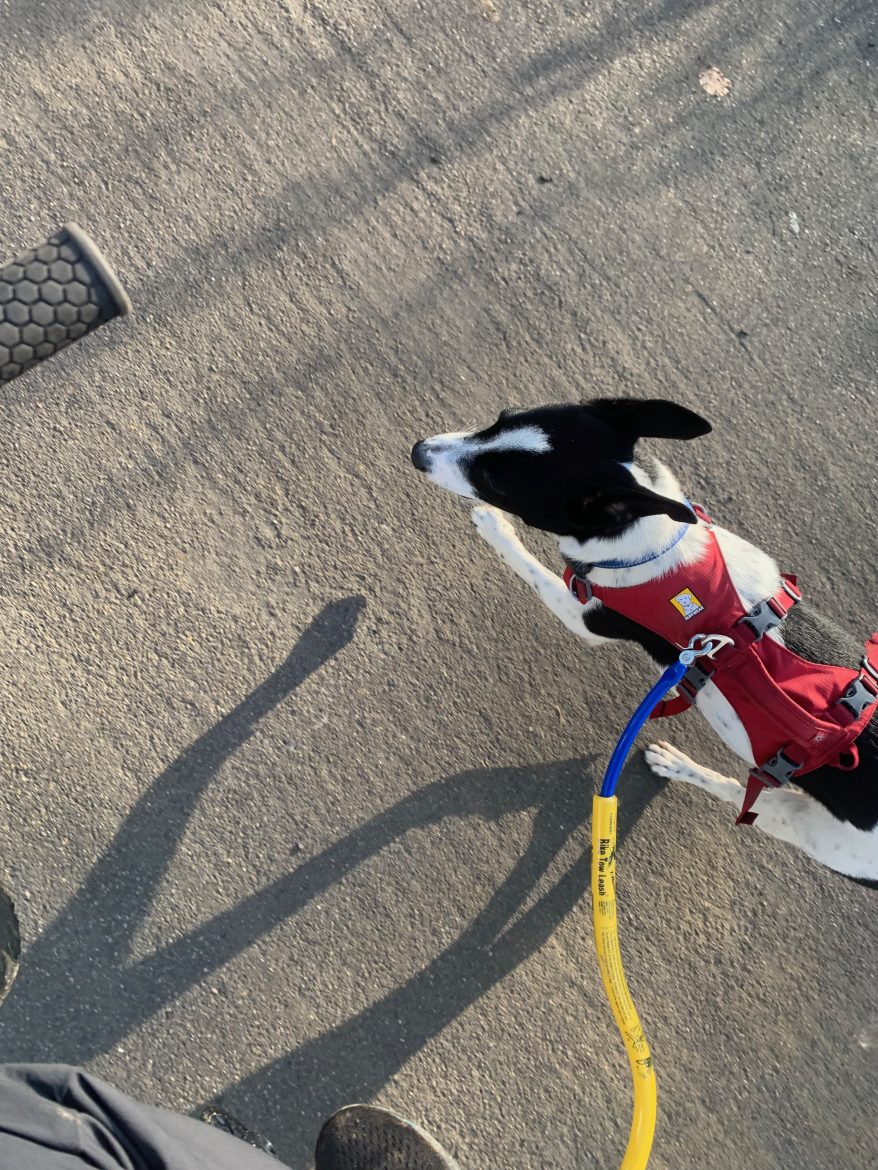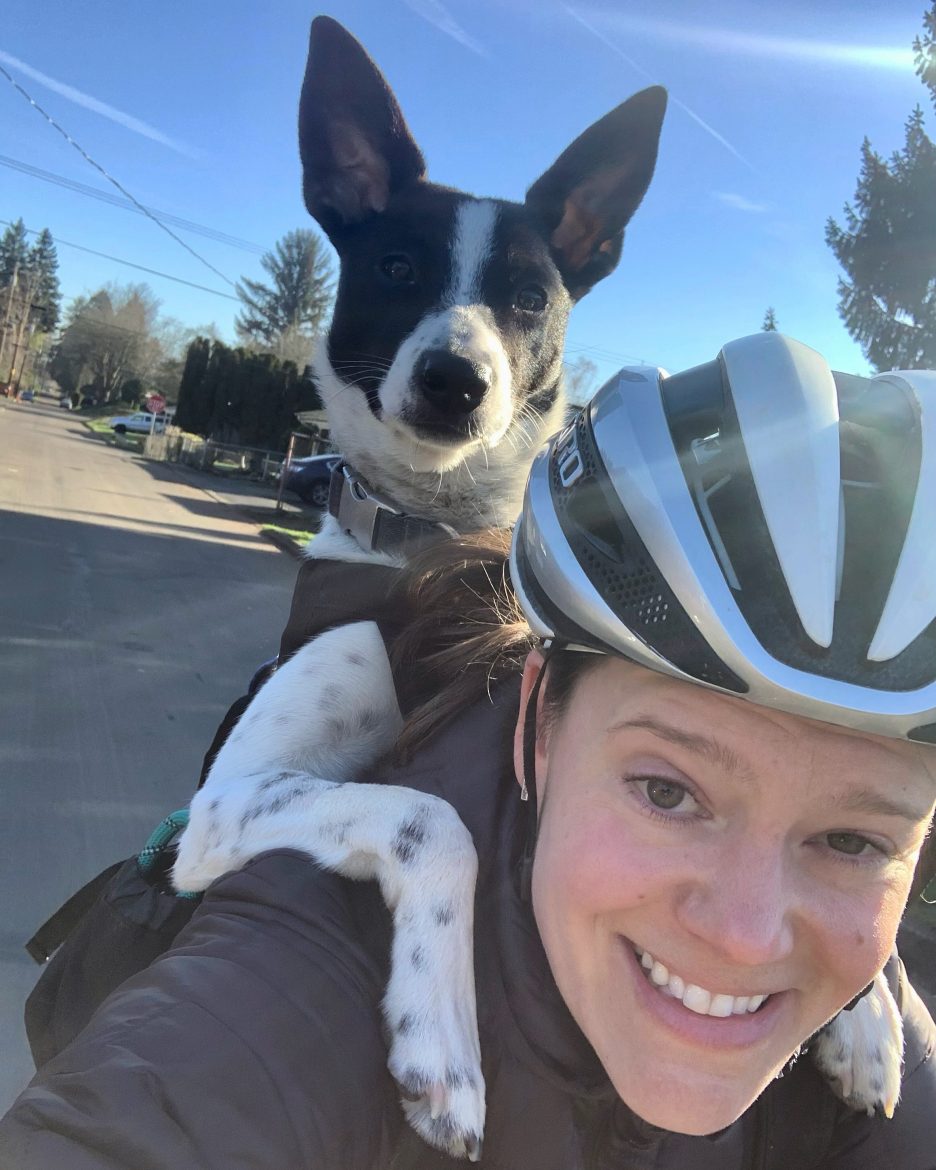
Like so many mountain bikers out there, when I adopted my dog, I was dreaming of having a trail dog and all the adventures we’d go on together. I purposely chose an active and trainable breed — he’s a Collie – Australian Cattle Dog mut — and I’ve been devouring training books, how-to guides, and YouTube videos ever since to make sure my pup will grow up to be a respectful trail user.
Recall, voice control, spatial awareness, general obedience, and fitness — it takes a lot of training before your four-legged friend is ready to hit some trails. After all, you’re sharing the dirt with a lot of other people, and a fair share of them don’t care for dogs (or bikes for that matter). When you’re out there riding, you and your dog become ambassadors for the sport and trail dogs everywhere. Any negative interaction could reflect poorly on the community as a whole.
This is why training your dog properly, picking up after them, and adhering to leash laws is important. Luckily, there are plenty of training tools to get your dog used to biking before hitting the trails for real.
Whether there are leash-laws in place, or you’re mingling with traffic, or your dog is still in obedience training, below are some options for riding with your pup when being off-leash isn’t an option.
*Disclaimer: When activitying with your dog, please have them wear a harness. Please don’t ever clip a bike attachment to your dog’s collar. I personally like Ruffwear’s Web Master Dog Harness with Handle, and Arcadia Trail’s Expandable Backpack Dog Harness.*
Bike Attachments
Amazon Bike Leash Attachment

Recognizing that many consumers’ purchasing decisions are influenced by whatever Google or Amazon serves them up in the search results, I decided to start with a bike leash attachment from Amazon. These leashes are all of a similar design: a metal rod with a seatpost clamp and a short fabric leash — sometimes with a bungee — that you clip onto your dog’s harness.
The clamp is easily installed on your seatpost with an Allen key, and you have the choice of having your dog run on either side of you. You clip the leash to your dog’s harness and you’re off in less than 10 minutes.
The concept is rather simple and effective… to a point. Yes, you can fit this on just about any bike — except those with a fully-inserted dropper post — and with a 16.5” stainless steel arm plus a short leash, there seems to be enough space for you to pedal without coming in conflict with your dog’s movement.
However, this is assuming your dog stays close beside you at all times, at a gentle trot and that the terrain is fairly even.
Using the device to ride the 2-mile jaunt to and from the dog park worked fine for a while. My dog would pull and steer the bike a little, but he’s a smallish guy and it didn’t bother me too much. That is until the day my dog decided he was going to greet another dog on the other side of the multi-use path. While the leash’s clips surprisingly held up, the clamp did not. The torque caused the clamp to twist around the seatpost, taking the paint off my seatpost as it did so, while I tumbled and got entwined with the leash and my dog. While no one was hurt, it terrified the dog and it took a serious amount of coaxing and treats to get him to trust being tethered to a bike again.
Aside from the movement of the clamp itself, perhaps a problem with the rod is its mounting location. Anytime you tether your dog to your bicycle, you risk the chance of tipping over when your dog pulls. However, the higher and further away from the center of gravity the force comes from, the easier you’re going to lose control over your bike.
This $30 device can certainly work if you have a taller dog that’s calm and obedient, and if you’re only going to take short jaunts on even terrain. For more energetic dogs or light mountain biking, this is not the device for you.
- Price: $30
- Available on Amazon.
- Pros: Installation couldn’t be easier; sturdy metal arm; easy to use; affordable.
- Cons: Despite the non-slip rubber interior, the clamp rotates if dog pulls; For smaller dogs, the height difference between the arm and the dog’s harness is hindering; Dog has free side-to-side movement, allowing them to potentially walk into your pedals; heavy.
Bike Tow Leash

Designed by an avid bike rider and mechanical engineer, the Bike Tow leash is an innovative take on the bike arm design described above.
It takes into account many of the issues users experienced with a seatpost-clamp-based bike arm. It has a low mounting location, it keeps the dog away from any moving parts, and the rod itself is flexible to prevent the dog from tipping or steering the bike. It even earned a 5-star safety rating from the American Pet Association and can be used with trikes and wheelchairs in addition to bicycles.
The 29-inch leash arm is made of a stiff and curvy inner core with a plastic coating and two flexible, rubber ends. One end connects the arm to a metal clamp to be used on your bike. The other end features a retractable clip for use with your dog’s harness. For tool-free mounting, the clamp attaches to your bike using two big knobs.
The first-time installation of this bike attachment takes a bit more effort than a simple seat post clamp. There are specific adapters and guidelines for using the attachment on the drivetrain side or non-drivetrain side, with or without quick releases, etc. Several small pieces like a vinyl flap and a spacer that’s kept in place with a zip-tie do give it a little bit of a home-engineered feel, but it all serves a purpose. And once you’ve done it a first time, subsequent removal and reinstallation are simple enough.
I opted for a drivetrain-side chainstay installation, but I will admit that for maximum ease of installation and no interaction with the drivetrain, the left-side installation or the quick-release adapter would be the better option. When attached on the right side, the chainstay clamp will cause chain rubbing and interaction in the lowest of gears.
Now onto the riding experience.
Right off the bat, it’s obvious that this bike attachment is a well-thought-out, superior device. The clamp sits much closer to the dog’s height, which provides a lot more stability. And while the flexibility of the arm gives the dog some freedom of movement, it also keeps the dog at, well, arm’s length. Thus, away from your feet and wheels. It actually keeps your dog at the “heel” position without the risk of entanglement.
The arm’s flexibility effectively absorbs any pulling or jerking or forces that would otherwise impede your bike control. The little retractable leash extension allows movement in any direction to accommodate uneven (though gentle) terrain.
I was generally impressed with this leash, and will happily continue using it as a training tool.
I do, however, want to state that no matter how good the tool, tethering a dog to your bike is only safe on the easiest and widest of trails where your movements are predictable and the pace is slow.
- Price: $146
- Available from BikeTowLeash.com and eBay.
- Pros: Low mounting height for stability; Flexible arm; Gives the dog some freedom of movement; Keeps dog away from moving parts; Absorbs jerking and pulling; Prevents steering and tipping of the bike.
- Cons: Takes some time to perfect the installation; On a short chainstay, you may clip your heel on the clamp; When attached on the right side, the chainstay clamp will cause chain rubbing/interaction.
Activity Leashes
Generally speaking, I don’t recommend using a regular dog leash while biking. Please don’t leash your dog to your bike by tying the leash to your bars or any other part of the bike. Not only is it dangerous for the dog, it can be a hazard for yourself as well. Just picture your dog spotting a squirrel, getting the zoomies, or getting the leash entangled with any of the moving parts. Yeah, now both of you are hitting the ground. With that said, for the purposes of this review, I do want to show some use cases for leashes.
Bark + Ride’s 2-in-1 Bungee Rope Leash

Bark + Ride is a Scottish company that designs “products for the adventurous and their dogs.” I came across their ingenious Poo-chi Pouch Top Tube Bag and was keen to find out what else they offer.
Their 2-in-1 Bungee Rope Leash is billed as a “must-have for any trail dog owner.” From daily walks to trail rides to stopping for a post-ride beer, this combo leash is meant to cover all bases.
It’s really a bungee leash and a rope leash that interconnect for a variety of uses. The bungee is stiffer than many running leashes out there for increased control while still absorbing any sharp pulls. There is a reflective thread weaved in throughout, and a handle with a quick-release clip as well as a D ring. On the other end of the leash, there’s a locking carabiner. The D ring allows you to wear the leash around your waist during your activity or when the leash isn’t in use.
At 28in long from handle to clip, the rope leash is a relatively short lead for close control. It seems strong and durable and features reflective elements, a comfy grip and a standard clip.
For use while activitying, you wear one leash around your waist and the other provides a connection between you and your dog. This allows you to keep your dog close while enjoying complete freedom of movement of your hands and arms.

While one could go riding in this fashion, the intended trail use case is to quickly and easily leash your dog and keep them close at trailheads, when crossing streets or when encountering other animals or vehicles. The idea is that your leash is easily accessible while also being completely out of the way while riding. You can ride for a short period with your dog in this fashion until it’s safe to let them run freely again. At the brewery post-ride, you can use the rope lead as a regular leash, or use the quick-release handle on the bungee to tether your dog to a picnic table.
It’s a widely versatile leash combo that has seen a lot of use at my house for everyday walks and the occasional run or ride. Wearing the leash is plenty comfortable but I do find having my dog so close to me while on the bike a tad uncomfortable, out of fear of striking him with my pedal. For the trailhead and street crossings, it works as described but I wouldn’t be comfortable riding with a dog tethered in this way for long periods of time.
- Price: $48 / £35
- Available at BarkAndRideSports.com.
- Pros: The 2-in-1 combo is so versatile, you really don’t need any other leashes; Wearing the leash around your waist is perfectly comfortable; The handle with quick release clip fits perfectly around a table leg or hitch rack; Bungee is stiff yet absorbs tension.
- Cons: Leash a tad short, which results in having your dog a little too close to you on the bike; Not ideal for longer outings.
Ruffwear Roamer™ Bungee Dog Leash

The Ruffwear Roamer™ Bungee Dog Leash a.k.a “the running leash” can be used in a similar fashion as described above. It sits comfortably around your waist while the other end attaches to your dog’s harness. The leash is longer than the Bark + Ride leash, which allows the dog more freedom of movement. This can be a good or a bad thing. On the one hand, he’s not so close to me that I fear I’ll hit him with my pedal. On the other hand, there’s a higher risk of entanglement and he’s got more freedom to run into my wheel. The bungee is also quite relaxed, giving him even more leeway. For running, this is my preferred leash. But for biking, I prefer a bike attachment like the Bike Tow Leash.
Dog-carrying Backpacks
I got a dog-carrier backpack on a whim a few months ago and it brings me a lot of joy and smiles to the faces of everyone we pass.
This purchase was inspired by professional road cyclist, Demi Vollering, who was posting stories on Instagram about riding with her dog in a backpack. She explained that she carries her dog in a backpack whenever it gets tired or until they reach an area where it’s safe to have the dog off-leash. For me to get to our nearest park, we have to cross several busy streets so I thought the backpack would be a great way to get around car-free yet safely. While my dog would prefer to run alongside me, I daresay he enjoys the vantage point from up high and the wind in his little face.
K9 Sport Sack Air 2
Dog accessories can get spendy, quickly, so I chose the minimalist Air 2 backpack mostly because of the reasonable price. Some of these dog carriers will run upwards of $260, and I wasn’t about to shell out that kind of money for something my dog may not even like. The backpack turned out to be a pleasantly good purchase, however.
While K9 Sport Sack makes dog carriers for dogs weighing up to 80lb, the Air 2 will only accommodate dogs weighing up to 30lb. The bag is available in four different sizes, which are set around one simple metric: the length from your dog’s collar to the base of the tail. A booster block is available for purchase separately for the really little guys.
A minimalist, form-fitting backpack, the Air 2 is constructed with a durable, single-layer Cordura® fabric and mesh on each side for extra breathability. There’s one full-length zipper on the outside, two external side pockets, two cinch straps, and a thin chest strap with a whistle clip.
When situated inside the bag, the dog will face forward, like you, with its two front paws resting on your shoulders. The dog is basically sitting on its haunches with its rear legs inside the bag, the front paws sticking through two reinforced slits, and the rest of the bag zipped up around them.

This is the simplest of bag offerings and is recommended only for intermediate-grade walks, hikes, public transportation, and bike rides. Bags for longer endeavors, sport more comfort-oriented features for both the dog and human.
I’ll admit that getting my dog inside the bag took some coaxing, some wrestling, and lots of treats. But now that he knows the drill, he knows that getting in the bag usually leads to fun adventures.
At 28 pounds, my dog is nearly at the max of this bag’s capacity, but it fits him well and he seems comfortable. Equally important is his safety. And with the cinch straps, the adjustable collar enclosure, and collar clip, my dog feels pretty secure in his bag, even if he wiggles from time to time. My comfort? I’m sure a waist strap and more substantial shoulder straps would make for a more comfortable experience, but for jaunts of 30 to 40 minutes at a time, the bag is perfectly wearable.
- Price: $75
- Available at K9SportSack.com and Amazon.
- Pros: Lightweight but sturdy fabric; Easy to clean; Well ventilated for dog’s comfort; Two side pockets for things like leashes and poop bags; Fur Flap to prevent catching your dog’s fur in the zipper.
- Cons: Not suitable for dogs weighing more than 30lb; A waist strap and more substantial shoulder straps would make for a more comfortable experience.
Which leashes or restraints have you found helpful for mountain biking with your dog?























